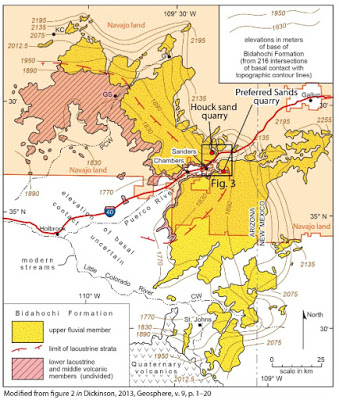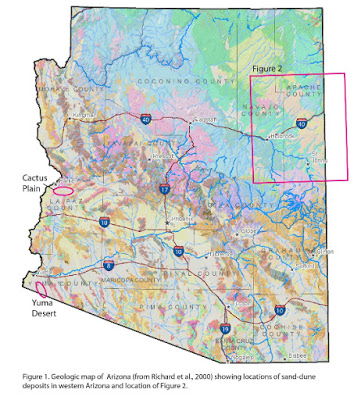
Nearly pure quartz sands have become increasingly important for oil and gas production. Although used for hydraulic fracturing (“fracking”) since at least the 1950s, the advent of directional drilling and improvements in hydraulic fracturing techniques have led to widespread exploitation of quartz sands that have appropriate properties for use in hydraulic fracturing(“fracsands”). Such sands are present in the upper Miocene to Pliocene upper Bidahochi Formation of northeastern Arizona. Other sand deposits are present in the State, but are not as well suited for use in hydraulic fracturing. This report is a brief review of the distribution and character of sands in Arizona that may have properties appropriate for use in hydraulic fracturing.
Bidahochi Formation
The Bidahochi Formation in northeastern Arizona(Figures1, 2)consists of three members: (1) a lower playa and lacustrine facies of middle Miocene age (Dallegge et al., 2001,2003), (2) a middle member consisting of mafic lava, volcaniclastic sandstone,and tuff of upper Miocene age(Sutton, 1974; Hackman and Olson, 1977; Ulrich et al., 1984; Damon and Spencer, 2001), and (3) an upper member that consists of fluvial and eolian sand,silt, and clay of uppermost Miocene to Pliocene age (Repenning and Irwin,1954; Repenning et al., 1958;Love, 1989).Although the Bidahochi Formation has beensubdividedinto members, the members are facies with complex depositional relationships(e.g., Kierschand Keller, 1955;Dickinson, 2013). The lower and middle members are completely missing from southern and eastern areas where the upper member rests on Paleozoic and Mesozoic strata (Figure 2).
In the Sanders area the upper, dominantly fluvial member includes bentonite clay deposits(it is not entirely clear that assignment of Bidahochi Formation members is meaningful in this area). The bentonite clay deposits, consisting of calcium montmorillonite and known as the Cheto mine deposits,havebeen exploited fordesiccants, gellants, and acid-activated bentonites since 1924 (Kiersch and Keller, 1955;Eyde and Eyde, 1987). The overlying silts and sands of the upper Bidahochi Formation include sand deposits that contain 93-99% SiO2(Table 1),some of which contain a large fraction of sand in the-20 +40 mesh size that is generally preferred for frac sands (Tables 2-5). Furthermore, the deposits can be mined with a front-end loader, unlike other frac-sand deposits in Texas and elsewhere that must be mined and processed by blasting and crushing (Eyde and Eyde, 1987).
The Preferred Sands plant and quarry (Figure 3) were active in 2015, with employment of 53 workers according to the U.S. Department of Labor (http://www.msha.gov/drs/drshome.htm). Employment reached 95 workers in2012 (actually “sum of average employment” based on hours worked as reported to the USDOL). The quarry operations are located largely at the site of the former Cheto bentonite quarries. Arizona Silica Sand Company was engaged in sand production at Houck through 2011according to the Arizona Mine Inspector’s annual report. However, the Houck silica sand plant and quarry (Figure 3) appeared from aerial imagery to be inactive, and a search of the U.S. Department of Labor web site yielded no information using the search terms “Arizona Silica”, “Houck Silica” and“Houck”.
Lower Colorado River Valley
Sand dunes are exposed over large areas in the Yuma Desert southeast of Yuma and at Cactus Plain southeast of Parker (Figure 1). In both areas sands deposited in the Colorado River Valley by the Colorado River have been displaced by winds and redeposited in sand dunes. Chemical analysis of dune sands from Cactus Plain near Parker and the Algodones Dunesin the Yuma desert near Yuma indicate silica content primarily in the 80-90% range, with none exceeding 90% (Zimbelman and Williams, 2002). Analyses of dune sands in the eastern Mojave Desert, west of the Colorado River, indicate silica content of consistently <80%, apparently because these sand deposits are upwind rather than downwind from quartz-rich sands delivered by the Colorado River (Zimbelman and Williams, 2002). Although Cactus Plain and the Algodones Dunes are both near railroad tracks and could be easily quarried, their physical properties are not appropriate for hydraulic fracturing sands because they contain too much feldspar and perhaps because of other factors such as small grain size.
Conclusion
The unusual purity of sand deposits in the upper Bidahochi Formation, containing little but quartz, and the adequate roundness and grain size, have made these deposits attractive for use in hydraulic fracturing. Other deposits in Arizona that could be economically quarried and processed have not been identified. Given the enormous aerial extent of the upper Bidahochi Formation, it seems likely that this area will continue to be exploited for frac sands as long as hydraulic fracturing remains a viable tool for oil and gas extraction.
Reference:
Spencer, J.E., Niemuth, N.J. Silica-sand deposits in Arizona. http://repository.azgs.az.gov/uri_gin/azgs/dlio/1643
Note: The above post is reprinted from materials provided by AZGS Document Repository.










